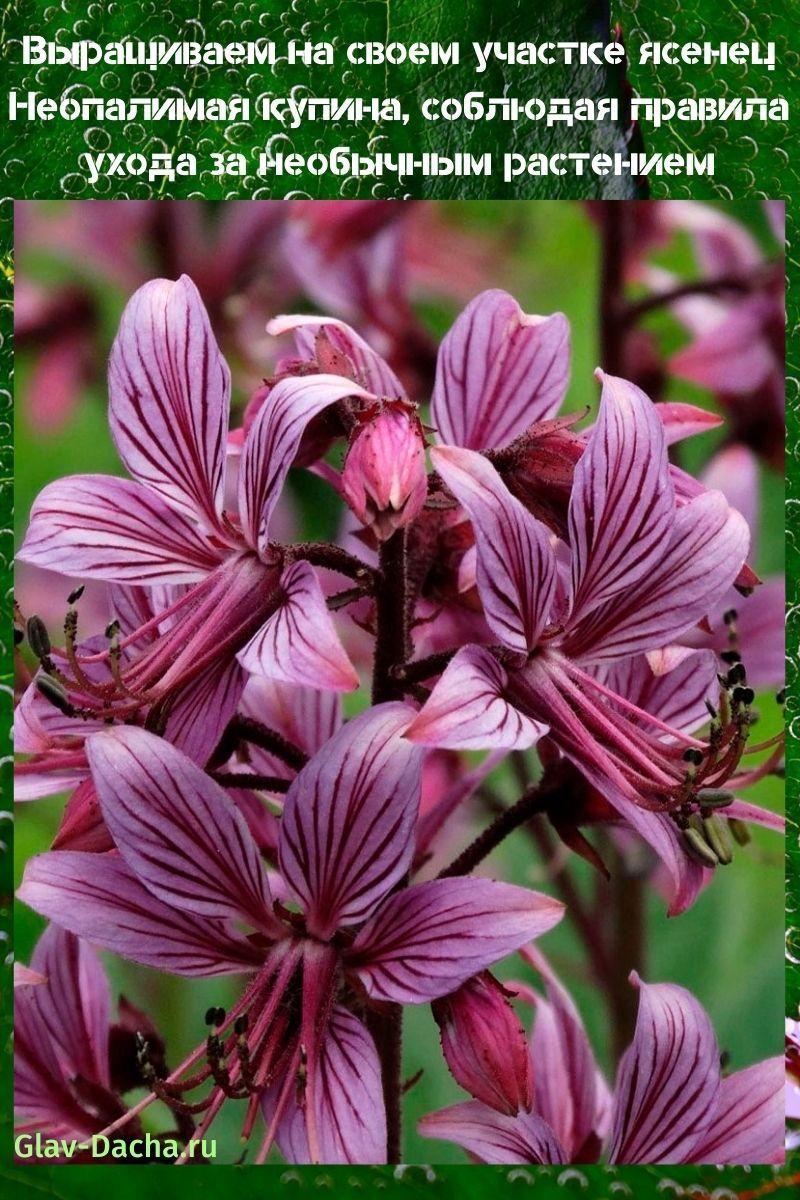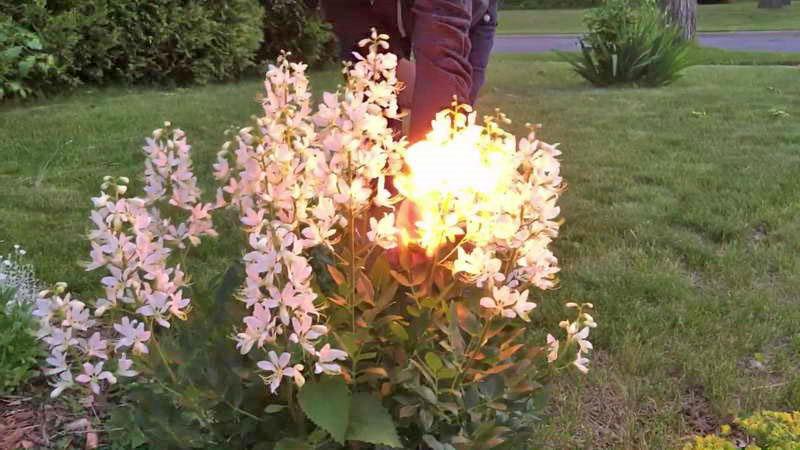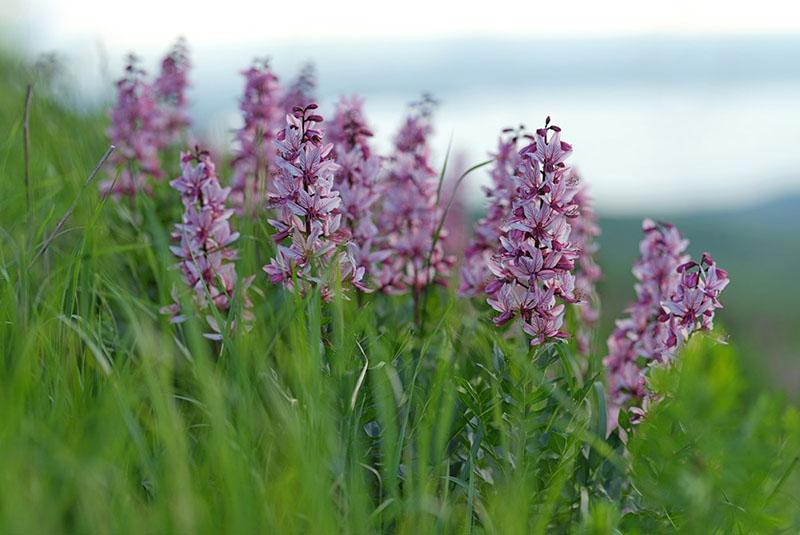We grow on our site the ash-tree Burning bush, observing the rules of caring for an unusual plant
 Ash Burning bush or dictamnus is a rare and exotic plant with an unusual name and spectacular appearance. We grow the ash tree Burning bush in our flower beds with the utmost attention and care, because this plant can cause severe burns. We are ready to put up with such a danger, because with proper care, the dictamnus "responds" with luxurious, lush flowering.
Ash Burning bush or dictamnus is a rare and exotic plant with an unusual name and spectacular appearance. We grow the ash tree Burning bush in our flower beds with the utmost attention and care, because this plant can cause severe burns. We are ready to put up with such a danger, because with proper care, the dictamnus "responds" with luxurious, lush flowering.
Main features of the Burning Bush

This feature is caused not by the supernatural "character" of the plant, but by the huge amount of essential oils in its composition. For the same reason, ash wood causes severe burns when touched.
The main features of the ash tree:
- The plant belongs to perennials up to 80-120 cm high, which create dense thickets in the process of growth.
- The ash plant has a large, powerful and branched root system.
- Stems are erect, with dense and dense edging.
- The leaves are odd-pinched, dark green, outwardly reminiscent of ash - this became the name for the culture.
- Inflorescences of the Burning Bush are red, pink or snow-white in color, with a pleasant citrus aroma. Flowering lasts until mid or late July.
- After the end of flowering on the stems of the ash tree, fruits are formed - "boxes" of a star-shaped shape, containing seeds.
Yasenets Burning bush is distinguished by high resistance to weather changes, undemanding to the quality of soil and aesthetic appeal. This ensured the popularity of dictamnus in landscape design.
Growing ash trees Burning bush
 When growing Ash Burning Bush, there are no strict requirements for the choice of soil. Under natural conditions, the plant grows easily in areas with rocky or clayey soil, with a minimum amount of moisture and nutrients.
When growing Ash Burning Bush, there are no strict requirements for the choice of soil. Under natural conditions, the plant grows easily in areas with rocky or clayey soil, with a minimum amount of moisture and nutrients.
The ash tree does not tolerate swampy soil, high humidity and excessive watering.
The most lush and vibrant blooms are provided by calcareous or alkaline soils. For the cultivation of the Burning Bush, it is best to choose evenly lit areas with light shading.
Growing from seeds
 Growing dictamnus from seeds is considered the simplest and most effective way of plant propagation. Sowing of an ash tree can be carried out in April or September. For planting work, it is best to choose a warm, but cloudy day - in hot weather, the seeds will not take root.
Growing dictamnus from seeds is considered the simplest and most effective way of plant propagation. Sowing of an ash tree can be carried out in April or September. For planting work, it is best to choose a warm, but cloudy day - in hot weather, the seeds will not take root.
It is best to use freshly harvested seeds for growing ash trees. In the case of using last year's seeds, young seedlings can appear from them only after 10-12 months, that is, most often next year.

Ash planting technique Burning bush:
- dig up the soil;
- prepare thin trenches or regular planting holes;
- sow seeds;
- Water the beds abundantly and sprinkle with a layer of soil.
After sowing, the beds must be watered regularly until sprouts appear, after which abundant watering stops.
 With the onset of spring, be sure to row the ash-tree sprouts, leaving a distance of at least 15-25 cm between them. Transplant the excess sprouts that noticeably thicken the beds separately. After 3 years, young ash bushes of the Burning Bush can be transplanted to a flower bed or other permanent place.
With the onset of spring, be sure to row the ash-tree sprouts, leaving a distance of at least 15-25 cm between them. Transplant the excess sprouts that noticeably thicken the beds separately. After 3 years, young ash bushes of the Burning Bush can be transplanted to a flower bed or other permanent place.
Ash tree care
 Planting and caring for the Ash Burning Bush is not particularly difficult. The plant is highly resistant to heat and tolerates summer drought well, without requiring frequent and abundant watering. The only exception is the flowering phase, which fell during a period of prolonged drought.
Planting and caring for the Ash Burning Bush is not particularly difficult. The plant is highly resistant to heat and tolerates summer drought well, without requiring frequent and abundant watering. The only exception is the flowering phase, which fell during a period of prolonged drought.
Ash The Burning Bush grows well on poor soil, without making fertilizers, but on rich soil gives a more lush and long-lasting flowering. Dictamnus does not tolerate neutral soil, therefore it is necessary to maintain a high level of alkalis.
For this, alkalizing dressings are introduced - best in April or May, once a year.
Fertilizers are applied 3 years after planting, if the soil is very poor - 2 years after sowing.
 The Ash Burning Bush does not need loosening of the soil, but a plant prone to rapid growth requires systematic pruning and bush formation. Pruning of dictamnus can be carried out both in autumn and spring. The optimal period is considered the end of March or the beginning of April, and in the fall - the period before the onset of the first frost.
The Ash Burning Bush does not need loosening of the soil, but a plant prone to rapid growth requires systematic pruning and bush formation. Pruning of dictamnus can be carried out both in autumn and spring. The optimal period is considered the end of March or the beginning of April, and in the fall - the period before the onset of the first frost.
 Ash Burning bush is highly frost-resistant, so no preparation of the plant for the winter season is required. Diktamnus tolerates sharp temperature changes and frosts without additional shelter.
Ash Burning bush is highly frost-resistant, so no preparation of the plant for the winter season is required. Diktamnus tolerates sharp temperature changes and frosts without additional shelter.
Diseases and pests
Dictamnus is extremely rarely exposed to diseases and "attacks" of insect pests. Rotting of the root system, which is most often caused by over-watering, is considered a common problem. It is necessary to reduce the moisture of the plant - this will restore its growth.
Security measures
 When growing an ash tree Burning bush and caring for a plant, you must remember about safety measures, otherwise you cannot avoid painful burns on the skin. In some cases, the plant can cause a strong allergic reaction, accompanied by fever, skin rashes and redness, and general weakness.
When growing an ash tree Burning bush and caring for a plant, you must remember about safety measures, otherwise you cannot avoid painful burns on the skin. In some cases, the plant can cause a strong allergic reaction, accompanied by fever, skin rashes and redness, and general weakness.
Basic security measures:
- do not smell ash flowers;
- touch the plant only with heavy protective gloves;
- wash your hands and face thoroughly after working with ash.
Ash Burning Bush is an unusual and very spectacular plant that will decorate the garden with lush and bright flowering. When planting and caring for dictamnus, you need to remember about its toxic properties and observe safety measures. This will help you enjoy the beautiful blossoms of the ash tree without any harm to your health.